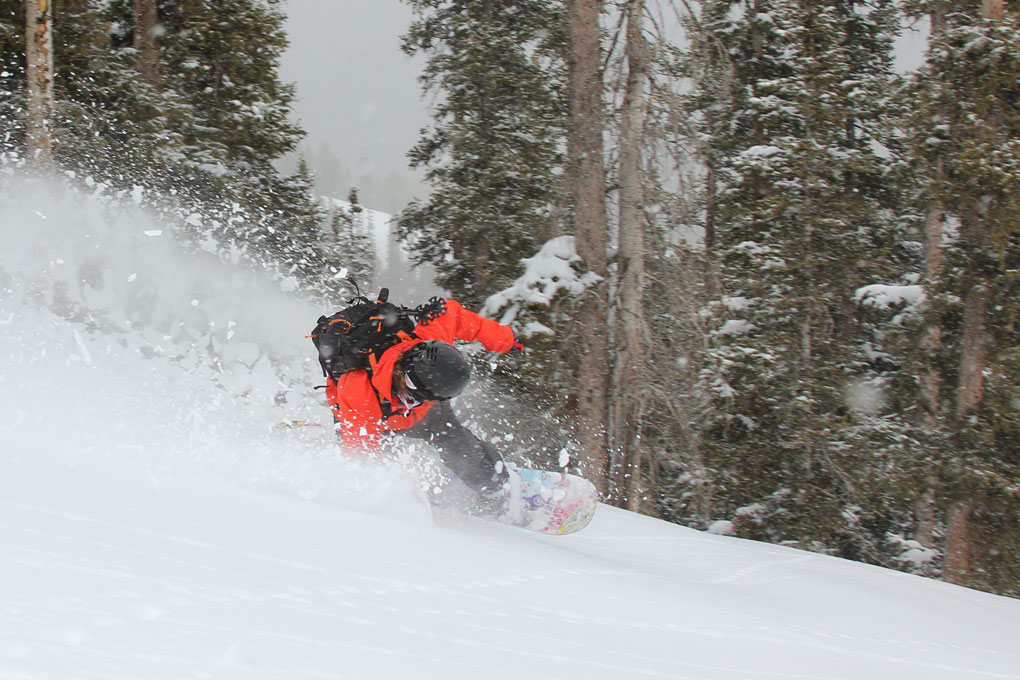Board Selection
Additionally, I’ve come to appreciate the variety of downhill experiences that the MTN Approach System allows. With a splitboard, riders are pegged with a single board for all snow conditions and terrain, which as everyone knows is variable from day to day and place to place.
With the MTN Approach System, you have the ability to ride any board from your quiver depending on the snow and terrain, which in my opinion is a huge advantage over other backcountry access and riding options.

Evan as I write this, I’m on my way back from riding backcountry in southern Colorado, where I had the option to ride either my 157 jib stick or my 163 freeride gun as I saw fit, rather than being stuck with one board for every run in every condition on each day.
Another example, in a place a little closer to home for me: Utah’s Little Cottonwood Canyon. In a span of a few miles, you can go from mellow, low-angle runs in Grizzly Gulch, to high-consequence, burly lines off Mt. Superior and the Y couloir. Depending on conditions and which line I’m looking to ride, a 164 directional board may not be as fun (or safe) as a 159 twin, or vice versa.
With the MTN Approach, I can choose the best board from my quiver to get the job done.
Durability
After using the MTN Approach off and on over the course of a year, I’ve been impressed so far with its durability. I’ve taken a few falls of varying severity (thanks to my own missteps), and the bindings haven’t bent or broken. The locking hinges on the skis have maintained their effectiveness and haven’t come undone once during an ascent.
The only tiny issue that I’ve had is a small corner (less than a square centimeter) of the skin peeling away from the front of one of the skis, something that was easily remedied with a dab of superglue. It’s evident to me that the MTN Approach skis are built to last.
Bottom Line
The MTN Approach System solves a few fundamental issues with backcountry riding: first, it allows for the rider to ride a fully intact snowboard, without the downhill performance issues that may bother some riders with a splitboard. Second, it allows for the rider to switch boards day to day depending on preference and conditions.
In addition to these core advantages, the maneuverability, low per-step weight, and skinning performance of the skis make for a pretty enjoyable uphill experience in most conditions.

Well, main question: would you take this over traditional splitboard?
Does the lower per-step weight better then having your board on the back?
Victor,
That’s a tough question with no short answer. For someone who might like to swap out boards from one day to the next, it’s far superior to a split setup. Would I prefer MTNapproach for a multi-day tour? No. But I can say that the per-step weight makes a noticeable difference over the course of a day trip, and I don’t mind having a board on my back too much. I’d say it comes down to personal preference, there are pros and cons for each setup. For what it’s worth, I use my MTNapproach more than my split.
Thanks,
Jed
Well, still hard decision. For example I have a some solid boards(swallowtails and freeride sticks), and I don’t really want to go for split because of it. MTN Approach might be a nice idea, because I can ride all my boards, and don’t need to get much stuff.
For me main question, does it worth trying mtnapproach? And doesn’t it perforn much worse then regular split ot not? I know that splitboard will probably be better then this.
I cannot decide what I’d like: lower per-step weight or having my board on a back.
Again, I’m kinda heavy guy(6″3 and 210+lbs), how does it perform in powder? I hope it will work ok with company of splitboarders though.
I gonna use it on a single day trips mostly.
just pure humor that in the modern era of aerospace tech they can’t make them like 1/2 that weight
i have mini skis the weight 3 lbs for the pair… now theres where they need to be …since my board is 6 thats less then 10 … all together… mt approach are truly lagging in technology!
Andy,
I agree that the lighter the skis are, the more effective the system. I’m sure that’s a priority at MTNapproach (and all other touring companies) moving forward.
Thanks,
Jed
Jed!
I appreciate the time you have taken for your review. I feel like I am a more aggressive rider so a split may take away from some of my style. However, as I lean toward mountain approach I wonder if it is worth the investment this season or will their technology develop into a lighter weight ski in the near future? When do you think mountain approach will release a lighter more improved model?
Cheers,
CHASE
Chase,
Thanks for the kind words. Your concerns are totally valid- investing $800 in a MTNapproach setup means you’ll want to use it for years to come. Their recent updates have included bolstering the joints with metal for more durability, but I haven’t seen or heard about an ultralight upgrade in the near future. It’s a tough call, but I think the system is totally capable as is. Hope this helps.
Thanks,
Jed
I purchased a mountain approach setup from the source snowboards calgary, used it four times then the hinge broke on one of the skis and one of the poles seized up and won’t extend, I believe the product is inferior and to be honest dangerous, taking something with plastic hinges into backcountry avalanche terrain is not a smart move, i would suggest spending the extra money on a splitboard and do it properly.